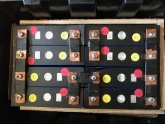dmcdetroit
New Member
- Joined
- May 31, 2020
- Messages
- 14
We inherited a DIY'd solar system when we bought a Sprinter 2500, and while documenting and moving the system to the rear of the vehicle, we discovered that the system is missing a battery management system. There is a lot of BMS advice here, but everyone seems to put their systems together differently, with different goals and requirements, and we find ourselves a bit stymied about how to make this decision in the context of the system we are working with.
Our cells are LiFePO4 3.2V, 135Ah, configured in a paired 8-battery array yielding 270Ah. You can see from the red-dot labels on the photo that the battery pairs at full charge are slightly over 3.2V each (3.37, 3.41, 3.33, 3.43).

Our questions:
Then we were advised that strapping the cells together would produce overheating and we needed cooling space between each individual cell to avoid a fire. We had not heard this before, and could not find any photos of a battery array that showed spacing between the individual cells. But if our configuration is unsafe, we want to fix it now, before we finalize the new installation. How have you handled this in your systems?
Thanks, all. We really want to get off-grid safely — and soon!
Our cells are LiFePO4 3.2V, 135Ah, configured in a paired 8-battery array yielding 270Ah. You can see from the red-dot labels on the photo that the battery pairs at full charge are slightly over 3.2V each (3.37, 3.41, 3.33, 3.43).

Our questions:
- What size BMS do we need for this configuration (and what variables are important in this decision)?
- Does our configuration indicate that we need more than one BMS, as some posts suggest? On what would we base this decision?
- What are the other important variables that we should consider?
- Do we have to equalize the battery loads before we hook up the BMS? and/or should we first discharge the batteries until they are below 3.2V, then turn on the BMS?
Then we were advised that strapping the cells together would produce overheating and we needed cooling space between each individual cell to avoid a fire. We had not heard this before, and could not find any photos of a battery array that showed spacing between the individual cells. But if our configuration is unsafe, we want to fix it now, before we finalize the new installation. How have you handled this in your systems?
Thanks, all. We really want to get off-grid safely — and soon!


